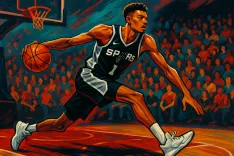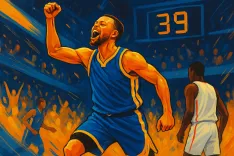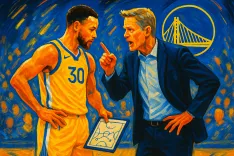Tough Financial Decisions Await NBA Teams Ahead of 2025-26 Season

Every action or inaction carries risk in the NBA. Teams are often constructed over the summer through drafts, free agency, and trades. While a significant player transaction like Luka Dončić can dramatically alter a team's trajectory during the season, most of the substantial maneuvering takes place in the offseason. In a league governed by salary caps, luxury taxes, and stipulations regarding spending, the intertwining of basketball decisions and financial implications is inevitable. Each franchise faces mixed pressures when navigating short- and long-term rostering strategies. In this context, we will examine the most pressing financial challenges that each team must address ahead of the 2025-26 regular season.
The NBA's new national television deals are set to commence this July, with projected salary cap increases to $154.6 million, reflecting the maximum allowable year-over-year increment of 10 percent. The exact figures for each team, as detailed later, rely on this cap projection. Though the NBA employs a soft salary cap system, it is common for teams to exceed this ceiling by the conclusion of each season. Some teams may choose to remain beneath the luxury tax threshold set at $187.9 million to benefit from the shared tax penalty distributions, while others may opt to stay below the first ($195.9 million) or second apron ($207.8 million), conscious of the limitations that accompany exceeding those lines.
Top contending teams are typically the only franchises willing to cross the second apron. Teams staying under the salary cap enjoy significant flexibility regarding trades and signings. That flexibility also grants access to a mid-level exception (RMLE) at $8.8 million. Alternatively, teams exceeding the cap but remaining below the first apron, regardless of tax standing, acquire the non-taxpayer mid-level exception (NTMLE) for $14.1 million and a bi-annual exception (BAE) worth $5.1 million, usable every other year. For teams above the first apron but below the second, the taxpayer mid-level exception (TMLE) amounts to $5.7 million, while those above the second apron forfeit such exceptions, allowing only minimum contracts, existing rights holders, and draft picks. Finally, there may be trade exceptions (TPE) from the 2024-25 regular season, where employing an existing one invokes a first-apron hard cap. Projections discussed herein do not contemplate potential trades or player waivers across multiple seasons.
For the Atlanta Hawks, last season concluded with a record of 40-42 and a play-in tally of 1-1. Entering the 2025 draft, they hold the 13th and 22nd picks. Their starting payroll is forecasted at $151.7 million, exceeding the cap, with exceptions including the NTMLE, BAE, a $25.2 million TPE from Dejounte Murray, and a $13.1 million TPE from Bogdan Bogdanović. Assuming a minimum payroll of $147.2 million provides them $7.4 million in space, with the potential maximum extending to $187.9 million, positioning them under the tax threshold.
Critical questions loom ahead for Atlanta regarding their commitment to Trae Young, alongside considerations for unrestricted free agents Clint Capela and Caris LeVert. The emergence of a healthy Jalen Johnson could drive the Hawks into playoff contention. Following the removal of general manager Landry Fields, the franchise now seeks a leading basketball executive who will play a vital role in these decisions. Atlanta's most pivotal choice may center on determining a suitable long-term deal for Dyson Daniels, who secured the Most Improved Player accolade and finished second in Defensive Player of the Year voting last season. Milton's extension eligibility comes ahead of the 2025-26 regular season, and he will likely seek a substantial reward for his contributions. Estimated compensation for Daniels could reach at least $94 million over four years.
The Boston Celtics concluded their 2024-25 campaign with a 61-21 record, paired with a playoff performance of 6-5. They enter the 2025 draft holding the 28th and 32nd picks, with a starting payroll positioned at $230.6 million, surpassing the second apron. The team currently has no exceptions but anticipates a minimum payroll of $232.2 million, while their initial repeater tax projection stands at $271.7 million. The Celtics’ trajectory, having been influenced by Jayson Tatum's Achilles injury, raises pressing evaluations regarding their burgeoning payroll and whether the current structure allows for sustainable competition with a healthy Tatum.
Players like Kristaps Porziņģis, with an expiring $30.7 million contract, and Jrue Holiday, owed $104 million over three years, may no longer be attainable luxuries under their financial constraints. Decisions surrounding the futures of free agents Al Horford and Luke Kornet remain unresolved, as Boston searches for valuable deals while preparing for a potential cost-cutting strategy this offseason.
The Brooklyn Nets, concluding the 2024-25 season at 26-56 and heading into the lottery with picks 8, 19, 26, 27, and 36, boast a starting payroll of $92.5 million, allowing them $62.1 million in cap space. With exceptions including the RMLE, their minimum payroll is set at $74.6 million. Brooklyn is notably positioned to explore options as few teams could match their expansive cap space this summer. This may lead them either to pursue star acquisitions or recalibrate by trading veterans such as Cam Johnson and Nicolas Claxton to further bolster their developmental outlook. Players like Cam Thomas, Day'Ron Sharpe, and Ziaire Williams hold reasonable cap holds, opening the door for roster decisions aimed at balancing the pursuit of top talent while maintaining a sustainable future.
The Charlotte Hornets faced a disappointing season, resulting in a 39-43 record and a play-in outcome of 0-1. Draft selections position the team with the 12th and 45th picks, while a starting payroll of $140.7 million, exceeding the cap, affords them $21.2 million in space. With exceptions like the NTMLE, BAE, and a $17.2 million TPE linked to Zach LaVine, they expect a minimum payroll of $133.5 million, comfortably under the tax threshold. Having lost the second overall pick Brandon Miller early in the last season due to a wrist injury, attention now turns to maintaining chemistry and assessing their roster’s core. Should Charlotte retain its foundational players while considering acquiring additional talent via draft options, or might they be inclined to explore trade avenues?
The Chicago Bulls concluded their 2024-25 season with a record of 39-43 and a play-in mark of 0-1, and they will have the 12th and 45th draft selections heading into the next season. Their starting payroll stands at $140.7 million, exceeding the cap and offering $21.2 million in space. The team holds exceptions including NTMLE and BAE, along with a $17.2 million TPE linked to Zach LaVine. With a minimum payroll set at $133.5 million, the Bulls seem positioned for a summer of decision-making centered around their backcourt prospects.
Coby White and Josh Giddey developed promising chemistry down the stretch of last season, leading to discussions regarding Giddey's performance in restricted free agency. With teams such as the Brooklyn Nets eyeing prospects like Giddey, the Bulls must assess how extensively they wish to invest to retain his services. Giddey is likely seeking a starting salary over $30 million, but negotiating a suitable agreement represents a challenge for Chicago as they historically practice fiscal caution. A compromise may result from a sign-and-trade arrangement, yet options could lie in retaining Giddey at an acceptable figure while potentially moving on from Nikola Vučević’s contract.
The Cleveland Cavaliers finished their 2024-25 campaign with a record of 64-18 and a 5-4 playoff mark, entering the 2025 draft with picks 49 and 58. Their starting payroll is estimated at $217.8 million, surpassing the second apron, suggesting an initial tax projection around $126.1 million. Cleveland’s offseason decisions will largely revolve around securing a contract extension for Christian Braun after their aggressive trade deadline moves, including the acquisition of De'Andre Hunter from the Atlanta Hawks. Despite falling short against the Indiana Pacers in the second round, the franchise is committed to building on what they believe is one of the league’s premier lineups, even as payroll pressure looms large.
The Dallas Mavericks concluded the 2024-25 regular season with a 50-32 record and a playoff tally of 7-7, possessing no selections in the upcoming draft. Their starting payroll rests at $199.5 million, in excess of the cap, supported by exceptions such as the TMLE. Their minimum payroll hovers around $197.9 million, against a maximum consideration of $207.8 million beneath the second apron. A key consideration will involve the future of Kyrie Irving, who, nursing an ACL tear, will not return to full strength until at least January.
Irving may opt out of his $44.0 million player option as an unrestricted free agent, but the uncertainty surrounding his recovery may curtail his potential market significantly. A logical course could entail Irving and the Mavericks negotiating a mutually beneficial three-year agreement that addresses the immediate financial landscape while also covering Irving’s long-term stability. This becomes particularly relevant for Dallas as they adapt to replacing Irving's ball-handling abilities throughout a portion of the season.
The Denver Nuggets look ahead after a 50-32 result last season, guided by a playoff performance of 2-4 and a draft pick at 37. The team’s starting payroll stands at $137.7 million, or over the cap with limited space. The Nuggets face critical decisions as they must consider extending Christian Braun while evaluating a possible trade involving Michael Porter Jr.'s sizeable contract. With playoff exposure under their belt, the need for flexibility maintains urgency for Denver moving forward.
The Detroit Pistons, closing with a 39-43 record and entering the upcoming draft with picks 1 and 20, look poised for growth after a season marked by proactive trades and the development of key players. As they approach the offseason, a question remains whether they will pursue star talent through free agency while maintaining a core group that performed favorably in recent competitions. The appeal of continuity versus aggressive recruitment will dictate their strategies as roster decisions need careful calibration.
The Golden State Warriors finished with a record of 48-34 and a playoff tally of 0-4, heading into the 2025 draft with choices at 48 and 56. Their starting payroll is forecasted at $137.1 million, providing a moderate level of flexibility. The focus on building around their core—Stephen Curry, Jimmy Butler, and Draymond Green—represents a commitment to a competitive window slated to extend through the next two years. Discussions will likely circulate around Jonathan Kuminga’s status as a potential sign-and-trade candidate, given the organization’s ambivalence towards his integration with their current framework.
The Houston Rockets, finishing 50-32 and progressing to the playoffs, have engaged in strategic growth with a young core eager to test playoff waters. As they aim to keep Fred VanVleet, financial calculations will include avenues for salary negotiation while continuing to build momentum. With acquisitions and draft strategy under consideration, Houston stands at a crossroads between maintaining stability and making bold moves at any potential trade deadline.
The Indiana Pacers navigated the 2024-25 season resiliently, achieving a record of 50-32 and a playoff performance of 3-4 while shaping up for a draft consisting of selections 30 and 51. Their payroll stands at $175.6 million, placing them above the cap. The possibility of entering the luxury tax hinges on decisions surrounding Myles Turner’s extension eligibility and the future of rising star Benedict Mathurin. Maintaining competitiveness while managing finances remains the Pacers' guiding principle.
The Los Angeles Clippers completed their last season at 50-32, concluding the playoffs with a1-4 record and taking in the No. 55 position in the upcoming draft. Due to a starting payroll of $191.6 million, any changes in player movement will be closely observed. As they assess the dynamics of their roster, the ongoing discussions regarding Paul George's longevity and potential James Harden contract adjustments will influence how they navigate upcoming financial commitments.
The Los Angeles Lakers, wrapping up their season with a 48-34 record and playoff results of 0-4, approach the offseason with aspirations for renewal. Their starting payroll stands at $137.1 million, enabling them opportunities with exceptions across various provisions. Focus on acquiring Luka Dončić, alongside available center options, has become a current strategic pillar as they assess market dynamics.
The Memphis Grizzlies, concluding their regular season at 37-45 and facing a play-in outcome of 2-0, are pursuing cap adjustments to facilitate Jaren Jackson Jr.'s forthcoming extension. There are viable concerns regarding retaining their roster depth while addressing player contracts amid concerns for future seasons.
The Miami Heat, determined to rebound from their first-round playoff exit, must not only examine Jimmy Butler's status but also plan for Tyler Herro's anticipated extension. The financial undertows will dictate organizational strategies as they value health and on-court performance towards building a contending team.
The Milwaukee Bucks face transitional challenges following Damian Lillard’s injury and concerns about sustaining Giannis Antetokounmpo’s competitive window. The potential to retain or let go of significant players could alter the franchise’s trajectory, and fervent discussions around the future may unfold as they balance their payroll against ambitions for title contention.
Vying for the right assets amidst fluctuating contracts, the Minnesota Timberwolves successfully navigated a trade that sent Karl-Anthony Towns to the Knicks while acquiring supporting figures. However, decision-making will need to wrestle with roster stability versus trading figures like Julius Randle and Naz Reid—considerations of overtime cost against advancing team cohesion. Draft picks are poised to facilitate financial adaptability into the next season.
The New Orleans Pelicans conclude a disheartening run, marked by injuries and the decision to move key players such as Brandon Ingram. As they prepare for the draft with the seventh overall pick, discussions of roster sustainability remain essential, alongside potential trades as they pivot away from the recent distress.
The New York Knicks aim to build off a promising campaign that saw Mikal Bridges elevate his profile in the postseason. Sustaining relationships within their roster will be crucial as they contemplate extending key players while gearing towards enhancing their competitive outlook.
The Oklahoma City Thunder, fresh off a solid season marked by two consecutive conference titles, are positioned to reward their stars Jalen Williams and Chet Holmgren with lucrative extensions. The Thunder will also address potential roster constraints with multiple contracts entering the fray for an infrastructure geared towards sustained success.
The Orlando Magic closed the 2024-25 season with a record of 50-32 and gained insights for development, yet they navigate through financial landscape adjustments dictated by upcoming extensions for star players. The potential to seek out complementary roles via trade may rise to the forefront of their summer objectives.
The Philadelphia 76ers suffered through a tumultuous season characterized by injury woes and federal uncertainty. Heading into the offseason, they must carefully weigh player commitments against a backdrop of anticipated contracts and team longevity.
The Phoenix Suns embark on another potentially transformative offseason, with the franchise aiming to reconfigure their roster and consider future trades involving Kevin Durant. As changes threaten to unfold, they confront financial complexities as compelling questions regarding their core remain prevalent.
The Portland Trail Blazers finished the 2024-25 campaign with a record of 40-42, marked by inquisitive pursuits in addressing player contracts. The team has the potential for strategic shifts, whether retaining budding prospects or seeking to revamp their core ahead of winter negotiations.
The Sacramento Kings underwent structural changes following a below-par season, and impending decisions regarding their roster composition will require astute evaluations on promising players like Keegan Murray—whose contract plays a pivotal role amidst a backdrop of uncertainty as the organization seeks talent to foster future success.
The San Antonio Spurs face both opportunities and challenges: key decisions from player evaluations, rapid changes necessitated by competition realities, and pivotal offseason moves to add supplementary talent as they set their sights on the dominant presence of franchise cornerstone Victor Wembanyama as the offseason progresses.
The Toronto Raptors look to recalibrate amid fiscal pressures while pursuing player retention strategies, especially with RJ Barrett and others under varying degrees of urgency as they refine their competitiveness heading into the next season.
Final assessments ahead of the league's 2025-26 campaign present numerous critical financial decisions across the NBA landscape, with franchises navigating complex payroll strategies intertwined with their aspirations for excellence.








